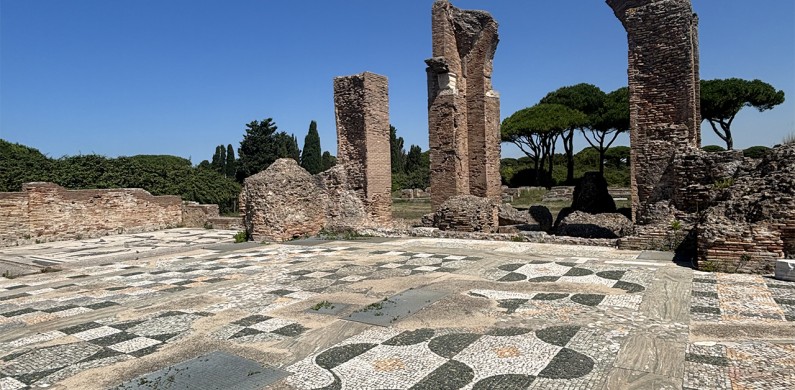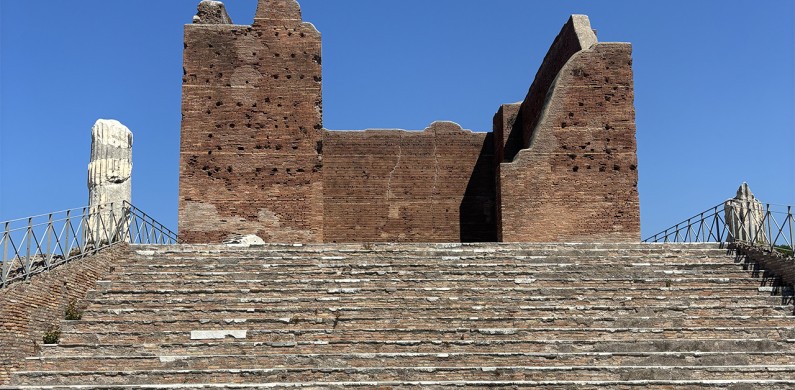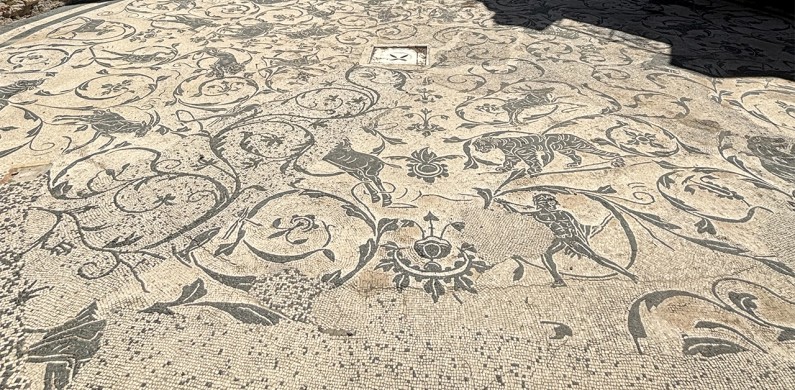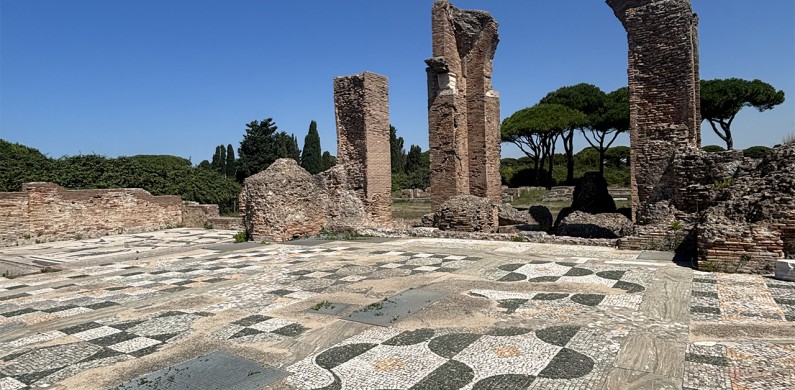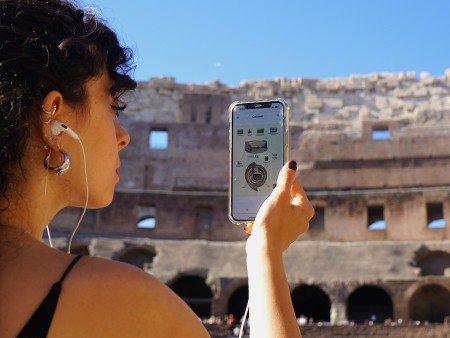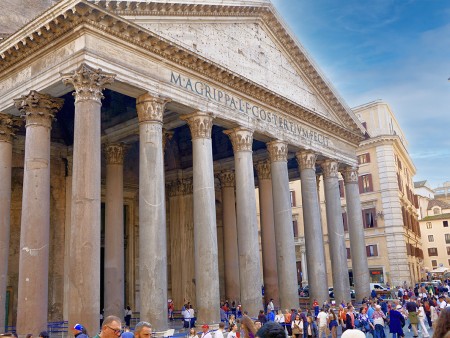Private Ostia Antica Tour from Rome by 15-min train ride
Enjoy our Ostia Antica Tour: a forgotten world of ancient streets, Roman baths, and magnificent frescoes with a smart guide
Step back in time on a private Ostia Antica Tour, the remarkably well-preserved ancient port of Rome. A short train ride from Rome transports you to a city that once pulsed with commerce, where traders, merchants, and sailors shaped the empire's fortunes. As you stroll through its cobbled streets, the grandeur of this city comes to life with your engaging guide, revealing intricate mosaics that once advertised the exotic wares of ancient merchants.
Marvel at the Baths of Neptune, where Romans gathered not just to bathe but to socialize, conduct business, and unwind beneath stunning mosaics of the sea god himself. Nearby, the Roman Theatre still echoes with the voices of actors and audiences from centuries past, its stone seats a testament to the cultural vibrancy of Ostia.
At the heart of the city, the towering Capitolium dominates the skyline, honoring Jupiter, Juno, and Minerva. But Ostia was a city of spiritual diversity, where secretive Mithraic cults worshiped in underground temples and one of Europe’s oldest synagogues stood as a symbol of the empire’s multiculturalism.
Wander through the House of Diana, a rare glimpse into ancient Roman apartment living, before stepping into a centuries-old tavern where locals once gathered over wine and lively conversation. As your journey through this forgotten metropolis ends, you’ll return to Rome with grand ambitions and enduring spirit of the ancient world.
Enhance your exploration of Roman heritage with our Colosseum Guided Audio Tour, where every stone echoes ancient stories.
Broaden your adventure with our Rome in a Day Tour, uncovering even more hidden treasures of the Eternal City.
Duration
5 hours
Private Tour
TOUR INCLUDES
Tickets to Ostia Antica Archaeological Park
Roundtrip transfer by train from Rome
Licensed guide with degree in archaeology, history or art history
Dynamic Passionate Guides, with perfect English and narrative skills
Itinerary carefully designed by our expert team
TOUR does't include
Food and Drinks
Main sites Explored in the Tour
Ostia Antica
Baths of Neptune
Roman Theatre of Ostia Antica
Forum of the Corporations
Capitolium
The Round Temple
House of Diana
Opening hours and Entry Tickets for this tour
2025 - Opening Days and Access Hours
From October 25th 2024 to February 28th 2025
- Tuesday - Sunday 8:30 AM - 4:30 PM (Last admission at 3:30 PM)
From March 1st to March 31th
- Tuesday - Sunday 8:30 AM - 5:15 PM (Last admission at 4:15 PM)
From April 1st to September 30th
- Tuesday - Sunday 8:30 AM - 7:00 PM (Last admission at 6:00 PM)
From October 1st to October 24th
- Tuesday - Sunday 8:30 AM - 6:30 PM (Last admission at 5:30 PM)
2025 - Closure Days
On the first Sunday of the month admission is free, so tickets can only be purchased at the ticket office in Piazza del Colosseo, located near the Temple of Venus and Rome, and at the ticket office in Largo della Salara Vecchia.
- 1 January
- 5 January
- 2 February
- 2 March
- 6 April
- 25 April
- 4 May
- 1 June
- 2 June
- 6 July
- 3 August
- 7 September
- 5 October
- 2 November
- 4 November
- 7 December
- 25 December
Embark on an extraordinary journey into the past as you leave the bustling streets of Rome behind and board a train bound for Ostia Antica, the remarkably well-preserved ancient port city of the Eternal Empire. This short but scenic ride not only offers picturesque views of the Roman countryside but also serves as a portal into history. Upon arrival, your private guide—steeped in the lore and legends of the past—will greet you warmly and set the stage for an immersive exploration of a city that once formed the beating heart of Rome’s maritime commerce.
Ostia Antica: The Gateway to Rome’s Maritime Might
Explore how Ostia Antica, deriving its name from the Latin word ostium meaning "mouth," was established as the primary harbor of ancient Rome and played a crucial role in the empire’s expansion. During its zenith, the city was a vital conduit for the grain, oil, and luxuries that flowed into Rome, supporting a population that peaked at nearly 80,000 inhabitants. As the Tiber River deposited layers of silt over centuries, Ostia was gradually buried inland, a transformation that paradoxically helped preserve its intricate network of streets, docks, warehouses, and temples.
At the heart of Ostia's commercial activity stood the Forum of the Corporations, a vast open-air complex that once housed the offices of traders and merchants from every corner of the Roman world. Here, you will see the intricate mosaics that still decorate the ground, illustrating the wares and services offered: wheat from Egypt, olive oil from Hispania, exotic animals from Africa. Each office had its own emblem, a marketing tool from antiquity that signaled the specialties of the traders who once gathered here. This was not just a place of commerce but of cultural exchange, where languages, goods, and ideas converged to shape the fortunes of an empire.
Rome's social habits: The Baths of Neptune and the Roman Theatre of Ostia Antica
As you will discover, no Roman city could thrive without its public baths, and Ostia boasted some of the most impressive. The Baths of Neptune, named for the mighty sea god, stand as a testament to Rome’s social customs. The massive bath complex, with its extensive system of heated floors and underground furnaces, was more than just a place for cleansing, it was a hub for socializing, networking, and even conducting business deals. At its heart you will find a breathtaking mosaic, still astonishingly well-preserved, depicting Neptune riding a chariot drawn by sea creatures, surrounded by mermaids and dolphins. The Romans believed bathing was essential to a civilized life, and standing on the upper level of the complex, one can almost hear the chatter of senators, merchants, and common citizens alike as they relaxed in the warm waters.
With your knowledgeable private guide, a short walk from the thermal baths will take you to the great Roman Theatre, a first-century BCE marvel that once seated up to 4,500 spectators. Designed with impeccable acoustics, this semi-circular arena hosted everything from theatrical performances and musical recitals to political speeches and religious ceremonies. The rows of stone seating, still intact, bear witness to the laughter and gasps of audiences long past. Behind the stage, elaborate backdrops once transported viewers to mythological settings or reenacted historical battles. Even today, in the summer months, the theatre springs back to life with performances under the open sky, offering a rare connection between ancient and modern artistic traditions.
Religious Diversity: Temples, Mystery Cults, and the Capitolium
Religion in Ostia was as diverse and dynamic as its population. In the heart of the city, the imposing Capitolium, dedicated to Jupiter, Juno, and Minerva, towers over the ruins, symbolizing the authority and divine favor that once underpinned Roman governance. Built to reflect the grandeur of its counterpart in Rome, this temple dominated the cityscape, reinforcing the idea that Ostia was a vital extension of the capital. Beyond these state-sanctioned temples, Ostia was a melting pot of spiritual traditions. Hidden among the ruins are the vestiges of Mithraic temples—mysterious underground sanctuaries where followers of the Persian deity Mithras practiced secretive rituals, and even one of the oldest known synagogues in Europe, which attests to the city’s rich tapestry of multicultural influences. Each sacred site, with its distinct architectural features and symbolic art, offers a window into the varied religious practices that coexisted within the empire.
Among the religious structures that dot Ostia Antica, the Round Temple stands out as a striking example of Roman devotion and architectural elegance. Likely dedicated to Hercules, the patron deity of traders and travelers, this circular sanctuary once housed a grand statue of the god, now lost to time. Romans believed that offering sacrifices here ensured safe journeys and prosperous ventures. The temple's unique design, with its columns encircling a central chamber, was an architectural innovation that would inspire later religious buildings throughout the empire. The site exudes a palpable sense of sanctity, where echoes of whispered prayers and the scent of burning incense seem to linger in the air.
Everyday Living: The House of Diana and Roman Residences
To truly understand the daily lives of Ostia's inhabitants, one must wander through its residential quarters. The House of Diana, one of the best-preserved insulae (apartment buildings) from the Roman world, offers a glimpse into urban life nearly two millennia ago. The multi-story structure, complete with narrow staircases, shared courtyards, and remnants of frescoed walls, tells a story of a densely populated and thriving community. Unlike the sprawling villas of the elite, buildings like the House of Diana catered to the middle-class merchants and craftsmen who formed the backbone of the city. Nearby, bakeries with large grinding stones and taverns with their original counters still in place illustrate the rhythm of everyday life, where the aroma of freshly baked bread and the murmur of evening gatherings once filled the air.
When your Ostia Antica Tour comes to an end, your guide will ensure your return to modernity by accompanying you to the train station for your return journey to Rome. Reflecting on the layers of history, from the echoes of ancient marketplaces to the solemn whispers of the necropolis, you will leave with a profound connection to a city that, despite the passage of time, continues to speak to the enduring legacy of the Roman Empire. This private tour not only illuminates the rich tapestry of Ostia’s past but also offers a uniquely personal window into the everyday life of an ancient metropolis—a true journey through time.
lexicon.1099
lexicon.1100
By submitting this form I agree to the processing of my personal data as indicated in the privacy policy
